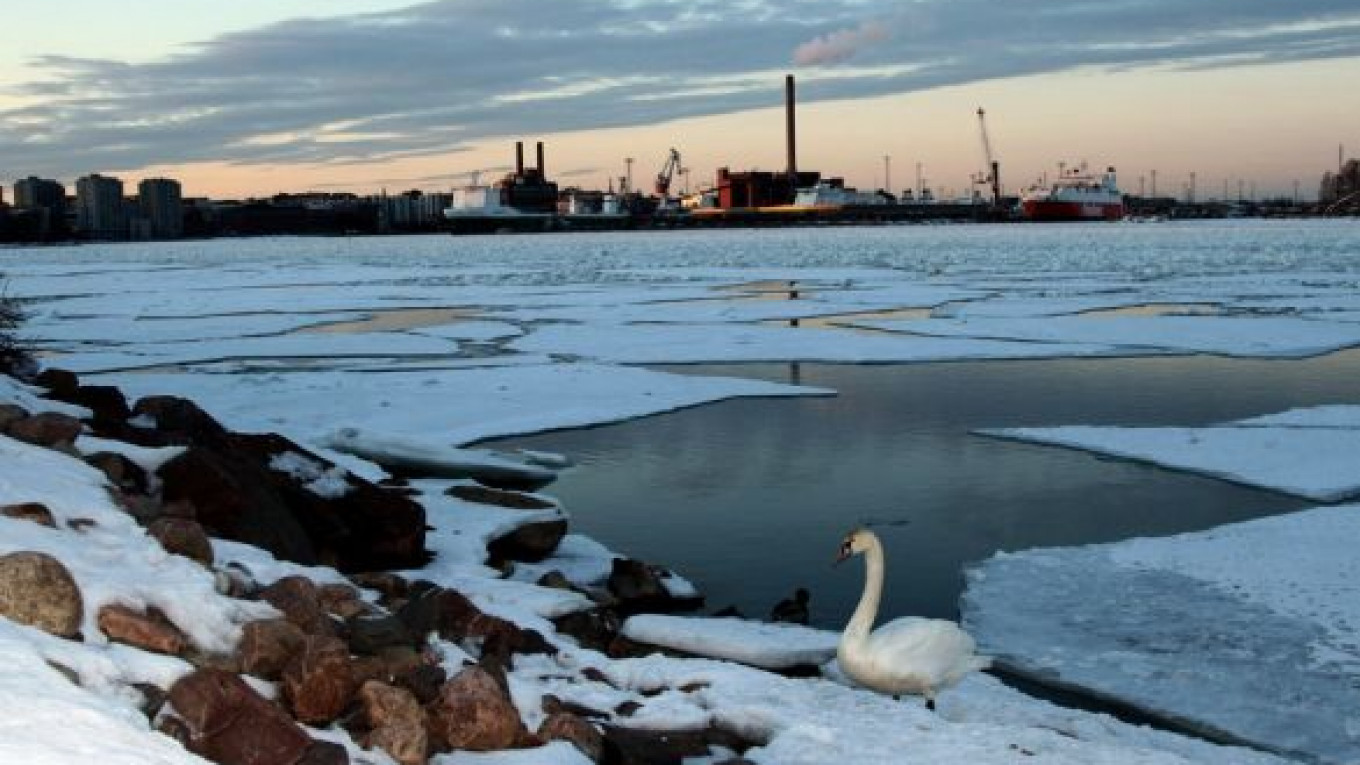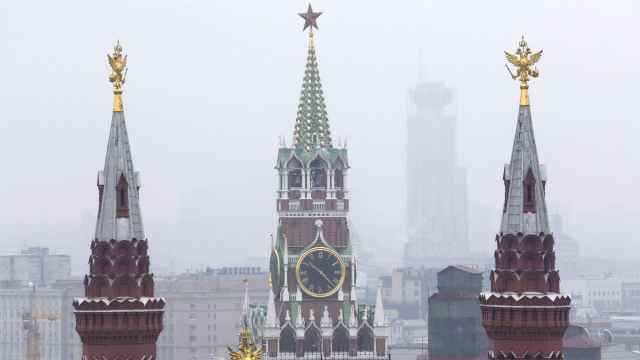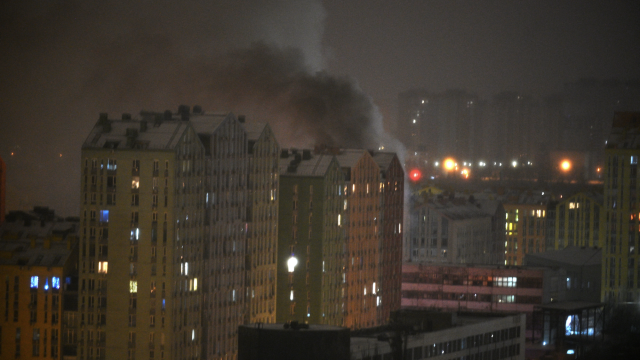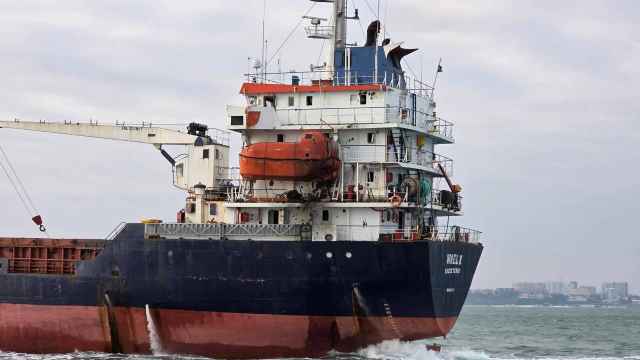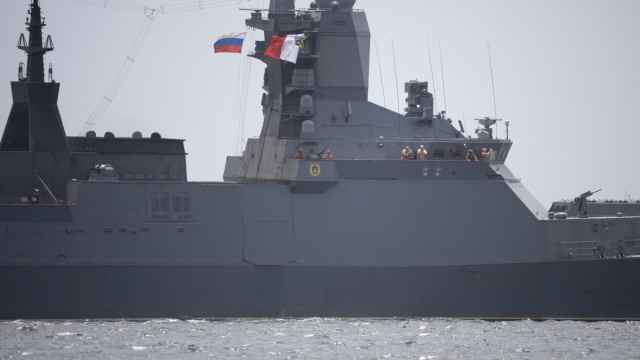More than three centuries after Peter the Great gave Russia access to the world by founding St. Petersburg as a "window onto Europe" at the head of the Gulf of Finland, area ports handle more than one-third of all oil exports and more than half of the country's container cargo turnover.
Sea traffic is growing at about 5 percent per year — leading to a boom in onshore infrastructure development, corresponding stress to the environment and risk of ecological disaster.
"The main contamination of the world's oceans is not happening at oil rigs, or other places where oil is being extracted — the share of such spills is only about 2 percent," said Valery Tsepelev, deputy head of the northwest branch of the Federal Service for Hydrometeorology and Environmental Monitoring, or Rosgidromet. The much greater risk comes from transportation, he said, mainly at the ports where oil is being loaded onto tankers.
While three modern port facilities in the area have come online, the specific fragility of the Baltic and Russia's antiquated fleet keep the risks as high as the rewards.
"The Baltic Sea is no less threatened and vulnerable a zone than the Arctic," said Viktor Afanasyev, deputy rector of the Makarov State Marine Academy in St. Petersburg.
One of the most important factors, Afanasyev said, is that the Baltic is an unusually frigid sea — with average temperatures of surface waters in the Gulf of Finland in summer at 15 to 17 degrees Celsius, dropping in winter to around freezing. Large areas of the Gulf of Finland are covered with ice up to 65 centimeters thick in winter months. In some parts of the Baltic Sea, ice floes and sea-bottom ice can be encountered as late as June.
That makes oil or chemical spills particularly risky, largely because no technology yet exists to clean up oil spills in frozen seas, said Alexei Knizhnikov, head of WWF Russia's oil and gas program.
The Baltic is also much less salty than other seas, and its brackish waters host a unique ecosystem of organisms that have adapted to life in such conditions. That makes any rapid changes in water salinity or chemical content extremely dangerous for the delicately evolved ecosystem.
And with an average depth of 50 and 60 meters — compared with 1,500 meters in the Mediterranean — the Baltic is unusually shallow. This factor and the narrowness of the Danish straits mean that its waters are replenished very slowly — about once every 30 years — therefore it takes much longer for the marine ecosystem to recover from the impact of pollution.
These three factors together make the sea uniquely vulnerable to oil spills, said Alexander Sutyagin, head of an environmental watchdog project called Monitoring the Baltic Pipeline System.
"The Gulf of Mexico could handle oil spills of several thousands of tons — the shallow Baltic Sea wouldn't survive. Even an oil spill of 10 tons could have an impact on the marine environment; a spill of 100 tons would be very hard to tackle; and a 1,000-ton spill would create an absolutely hopeless situation," he said.
Climate change is a wild card that also has a serious impact on the Baltic. "The weather is in a feverish state," Tsepelev said. According to Rosgidromet, average temperatures in the southern Baltic have risen by a full degree over the last 50 years, and by two degrees in the north.
"We're seeing a growing number of extreme situations in which catastrophic conditions, such as high waters, storms and extreme weather, may occur more often than before," Tsepelev added, which puts the risk of maritime disaster even higher.
Port Renaissance
As the force of nature shows its strength, the force of commerce is also demonstrating how relentless it can be.
While politicians and businessmen talked for the last 20 years about the need to increase capacity at Baltic ports, some logistics firms left for more spacious facilities in nearby Finland and the Baltic states. About one-third of all Russian imports are now estimated to arrive via Finland, costing St. Petersburg 27 billion to 30 billion rubles ($895 million to $995 million) per year in lost revenue, according to the city administration's committee of transportation and transit policy.
In the past several years, the government has pumped vast amounts of money into remedying this, and a number of large-scale investment projects have already been completed. Brand-new port facilities have opened in Ust-Luga, Vysotsk and Primorsk, and new pipelines like Nord Stream — which carries natural gas beneath the Baltic directly to Germany — have been laid to ease hydrocarbon exports. Still more ambitious developments of port facilities in the Russian Baltic are in the works — and environmentalists are seriously concerned.
"Such development reflects the increasing prosperity in the region — it is a good sign. But at the same time one has to ensure that this transportation is not posing a risk to the marine environment and ecosystem," said Monika Stankiewicz, executive secretary of the Helsinki Commission, or HELCOM, an international body that monitors environmental safety in the Baltic.
One-hundred and fifty kilometers west of St. Petersburg along the southern shore of the gulf lies Ust-Luga, another newly built port that went into operation in 2001.
The Ust-Luga Group, the port's developers, are ambitious, having recently made public bold plans to double cargo shipping every year (annual turnover is currently 22.7 million tons), open a new car terminal with a capacity of 250,000 cars per year and invest about 52.5 billion rubles in rail links. By 2018 they even plan to construct a new freight airport for transferring cargo to Siberia and the Far East.
Ust-Luga also hosts the terminal of the 1,100-kilometer Baltic Pipeline System 2, or BPS-2, built by Transneft as an alternative route to European markets after a trade dispute interrupted supplies through the Druzhba pipeline via Belarus in 2007.
The port began to receive oil from BPS-2 in March this year. So far it is still working under a "test regime," and only two tankers have been filled, but at full capacity it is meant to pump 30,000 tons of oil a year for export to EU countries via the port.
Ust-Luga and BPS-2 have both been criticized by Russian and international environmentalists. The German environmental organization NABU claims that the oil terminal may be threatened by landslides, which could cause oil spills in the Baltic Sea.
Gunnar Noren, general secretary of the Clean Baltic Coalition, claims that further development of Ust-Luga is a threat to salmon, whose migration routes pass the mouth of the bay.
Yulia Aksyonova, the head of KinEK, a subsidiary of Ust-Luga charged with dealing with environmental aspects of the port's development, says the threat to the wildlife of the Gulf of Finland has been overblown. "Construction works will mostly affect shallow areas of seabed. The feeding grounds for some fish species may disappear, but usually within three to five years plant marine flora is already recovering," she told The Moscow Times.
Another project has sprung up not far from the town of Lomonosov, an outlying suburb of St. Petersburg on the south bank of the Gulf of Finland.
The Bronka transshipment center is a new facility designed to handle the overflow of container traffic from the overburdened port of St. Petersburg.
One of the largest infrastructure development projects in the region, Bronka, is due to open in 2014. Developers expect it to handle 22 million tons of roll-on-roll-off and container cargo per year when fully operational.
Fenix, the investment company behind the project, says the new port will create 2,000 jobs and bring the city 8.5 billion rubles a year in tax revenues. The company also says the new facility will ease road traffic congestion in some central districts of St. Petersburg and, of course, boost the competitiveness of Russia's Baltic ports.
Vladimir Zhuravlyov, a municipal deputy from Lomonosov, has been protesting against Bronka for the last few years.
"Such massive construction could inflict unthinkable harm on the environment. The shallows are home to species of plankton that larger species of fish and birds feed on. Also, young smelt find their food in the shallow waters — 80 percent of the migration routes of this very iconic St. Petersburg fish go through this area," Zhuravlyov said.
Vera Ovcharenko from the Baltic Nature Foundation points out that dredging works in the port of Bronka area kill Baltic herring spawn.
Others are less worried about fish than about existing infrastructure. Dredging work — which alone is set to cost 15.2 billion rubles — will be carried out not far from Bronka, next to the St. Petersburg flood-defense dam and the road tunnel that runs beneath it to Kronstadt Island in the middle of the gulf.
"It is still unclear how the muddy ground will react to new construction. Apart from that, the dam was built without taking into consideration a new large port facility nearby," said Sergei Malkov, a deputy with the St. Petersburg city parliament.
Oranienbaum City, an NGO that takes its name from the town of Lomonosov's pre-1948 name, claims that the Bronka project could repeat the negative impact of massive land reclamation on St. Petersburg's Vasilyevsky Island in 2006. "The two-year-long construction created tons of lime deposits, which led to a massive decrease in the fish population," said Alexander Tolkachyov, an expert with the NGO.
Risks vs. Rewards
The threat of oil spills is rising as new terminals are installed and shipping grows, said the WWF's Knizhnikov. "Construction of new terminals and increasing cargo transportation brings along higher risks," he said.
Noren of the Clean Baltic Coalition said oil and other cargoes are quite often being carried on old, single-hull ships that do not meet modern standards.
Russia could do much to change this itself, said Olga Senova of Friends of the Baltic, an NGO. "Countries willing to protect their seas from oil spills introduce special requirements for oil tankers coming to their ports, for example, a requirement for double hulls. However, our ports in the Gulf of Finland still accept single-hull vessels," she said.
The Baltic was granted the status of a "particularly sensitive area" in 2003 by the Council of the Baltic Sea States in order to protect it from poor-quality vessels, including those with single hulls. But Russia has refused to comply with the requirements, and the restrictions are not enforced in Russian territorial waters.
Commenting on the issue in June 2005, President Vladimir Putin said international environmental cooperation should be used to benefit Russia and not as an "instrument of competitive struggle against the development of our economy."
Stankiewicz of HELCOM said there are some additional measures that Russia subscribes to. For example, restrictions on sewage discharges from vessels, especially passenger ferries and cruise liners, are applied in all countries.
And those rules are about to get even stricter. Russia has agreed to EU regulations set to come into effect in 2015 that will require all vessels passing through the Baltic Sea to use fuel with no more than 0.1 percent of sulfur, which is one-fifteenth of the present limit.
Measuring the Threat
Just how much oil is spilled is hard to measure, partly because of a dearth of data. WWF Russia recorded 31 "officially" recognized oil spills of more than 10 liters in all Russian seas in 2010, but Knizhnikov says information on oil spills in the Russian Baltic is not publicly accessible.
Official statistics do confirm that several times over the past year concentrations of oil and other chemicals in the Baltic have reached two to four times the maximum allowable levels.
According to Sutyagin, oil spills in the Baltic quite often go unmonitored. "Information is only exposed when a vessel goes by and notices an oil spill. Nowadays, there is more transportation, shipping traffic is increasing — and if we don't have an adequate control system, we won't know whether there is an oil spill, where exactly it is, which direction it is moving in," he said.
There are efforts to mitigate the risks. In HELCOM, the coastal states cooperate to build readiness to respond to major oil spills from shipping accidents, Stankiewicz said. In addition, specific HELCOM regulations require that the countries exchange information in case of the construction of an installation with a significant potential adverse impact on the Baltic Sea.
Meanwhile, a team of researchers at Finland's Aalto University is trying to calculate and minimize the risks of oil transportation in the Gulf of Finland. Another research project is looking at how the increase in shipping traffic influences the probability of collision by evaluating AIS data — a system under which every individual vessel over 300 tons sends in details like position, course, speed, draft and cargo. The information is then available to other ships in the area and stored in a shore-based database.
That gives the researchers a complete "snapshot" of shipping over a given area for a given time period. "We know how the ships are navigating, how many of them and what types and sizes," said Jakub Motewka, a researcher in the team.
Mitigation on Paper
Growing tanker traffic is having a horrendous impact on the Baltic's seals — the local populations of grey and ringed seals have barely recovered from near devastation due to overhunting in the 1970s and 1980s.
"We hope to make a full-scale study of the Baltic seal population and suggest further measures for eliminating the negative impacts. But it is certainly necessary to carry out certain compensatory measures — like in the case of the Nord Stream pipeline, a new marine nature reserve [the Ingermanlandsky Zapovednik] was proposed in the Gulf of Finland," Knizhnikov said.
But promises are not always kept. Even though all documents are ready and all expert evaluations have been carried out, "The nature reserve offered by Nord Stream in 2010 still hasn't been created," Knizhnikov said.
A Message from The Moscow Times:
Dear readers,
We are facing unprecedented challenges. Russia's Prosecutor General's Office has designated The Moscow Times as an "undesirable" organization, criminalizing our work and putting our staff at risk of prosecution. This follows our earlier unjust labeling as a "foreign agent."
These actions are direct attempts to silence independent journalism in Russia. The authorities claim our work "discredits the decisions of the Russian leadership." We see things differently: we strive to provide accurate, unbiased reporting on Russia.
We, the journalists of The Moscow Times, refuse to be silenced. But to continue our work, we need your help.
Your support, no matter how small, makes a world of difference. If you can, please support us monthly starting from just $2. It's quick to set up, and every contribution makes a significant impact.
By supporting The Moscow Times, you're defending open, independent journalism in the face of repression. Thank you for standing with us.
Remind me later.



